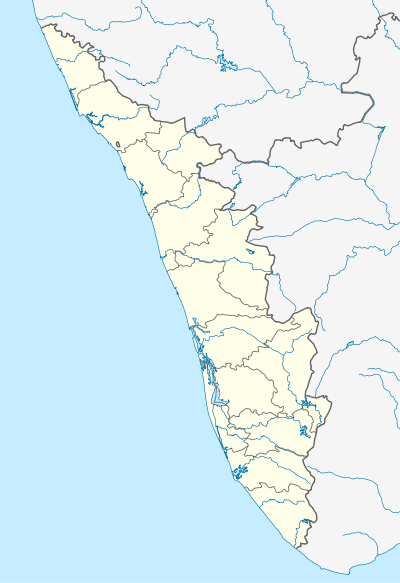Valayanad Devi Temple

| Valayanad Devi Temple | |
|---|---|
 Valayanad Devi Temple Location in Kerala | |
| Name | |
| Proper name | Sree Valayanad Devi Kshetram |
| Geography | |
| Coordinates | 11°14′37″N 75°48′13″E / 11.24361°N 75.80361°ECoordinates: 11°14′37″N 75°48′13″E / 11.24361°N 75.80361°E |
| Country | India |
| State | Kerala |
| District | Kozhikode |
| Location | Valayanad |
| Culture | |
| Consort | Goddess Parvathy |
| Architecture | |
| Architectural styles | Dravidian architecture (Kovil) |
Sree Valayanad Devi Temple dedicated to Bhagavathy, is situated in Valayanad, Kerala, India.[1]
History
Valayanad Bhagavathi is the family deity of the Zamorin Kings ( Ilayidath Swaroompam ), who ruled Kozhikode in the medieval period. Legends say that in a fight between the Zamorin and Valluva Konathiri (the king of Valluvanad), the Zamorin got defeated in spite of having better military and financial might. The Zamorin pondered this, and decided that the Bhagavathy's blessings were with Valluvakonathiri. The Zamorin undertook Tapas in disguise, at Thirumanthamkunnu temple, the family temple of Valluvakonathiri, until Devi manifested before him.
The Zamorin requested Bhagavathy to come to his kingdom. While they were travelling, Devi told Zamorin that whenever he hesitates and turns back to check whether Devi was with him, she will return immediately. After some time, when the jingling of her dance-bells could not be heard, the Zamorin looked back. Immediately Devi told him that she wouldn't come any further, but as a reward for the Zamorin's devotion, would throw her bangle, and the spot where it fell would have her presence. This bangle rotated for a week and landed at the place where the temple now stands. The place where the bangle rotated for a week came to be known as Azhchavattom and the place where the bangle fell became Thiruvalayanad.
Description
Valayanad Devi temple, dedicated to Bhagavathy, is situated in Valayanad on Mankavu Govindapuram route in the city of Kozhikode. The temple, which faces north, has four gopurams. The Devi temple at Valayanad has its own distinct identity and is different in several respects from other Devi temples in India. It is one of the Saktheya temples where pujas are performed in accordance with practice of Ruruji worship. The presiding deity of this temple is the goddess from Kashmir, known as Chandika, also called Mahartham and Kalasarppini.
The priests of this temple who perform pooja according to "Saktheya" injunctions in this temple are Moosads who follow the Kashimiri way of worshipping. The Sreechakra, designed by the great Sivayogi Thayyavur Sivasankar, remains in the sanctum sanctorum, where the presence of the goddess is believed to be ever present. Idols of Shiva, Thevaara Bhagavathi, Lord Ayyappa, and Vigneswara, Ksethrapaalan (Lord Subrahmanya) are also consecrated in this temple. In the sanctum sanctorum on the southern wall idols of Sapthamathrukkal ( seven mother Goddesses) is encarved. An important ritual conducted in this temple is the Guruthy Tharpanam.
The annual festival commences every year on the day of Karthika of Makaram and continues for seven days. Devi's 'utavall is Kept in Tali Mahadeva Temple. Few days before the 'Uthsavam'( festival) It is taken to Valayanad temple.The 'Arat'( the holy dipping of the idol after the 'Pallivetta') is conducted in Trissaala kulam in Mankavu. During the annual festival There will be not Madhyama ( saktheya ) Pooja. Brahmins were brought the temple to perform the Uthama Pooja. Kalamezhuthupattu is observed from 1st Vrichikam for 41 days during the Mandala season.Tuesdays and Fridays are considered to be more auspicious for praying in this temple.
The temple priests
There are five Moosad families residing around the Sri Valayanad Kavu. They have the traditional right to do observances in the temple.The five illams are Vattoli-illam, Vadakke-illam, Kozhiparambillam, Naduvilakandi, and Kozhikodanparambu. The chief poojaris are Vattoli-illam and Vadakke-illam, as an inherited right.
See also
References
- ↑ "Sree Valayanadu Devi Temple | Kommeri, Mankavu | Calicut / Kozhikode Temples | Hindu Temples in Kerala | Valayanad Devi Temple | Kommeri | Calicut Temples". Sreevalayanaddevi.org. 2011-07-28. Retrieved 2012-12-16.
